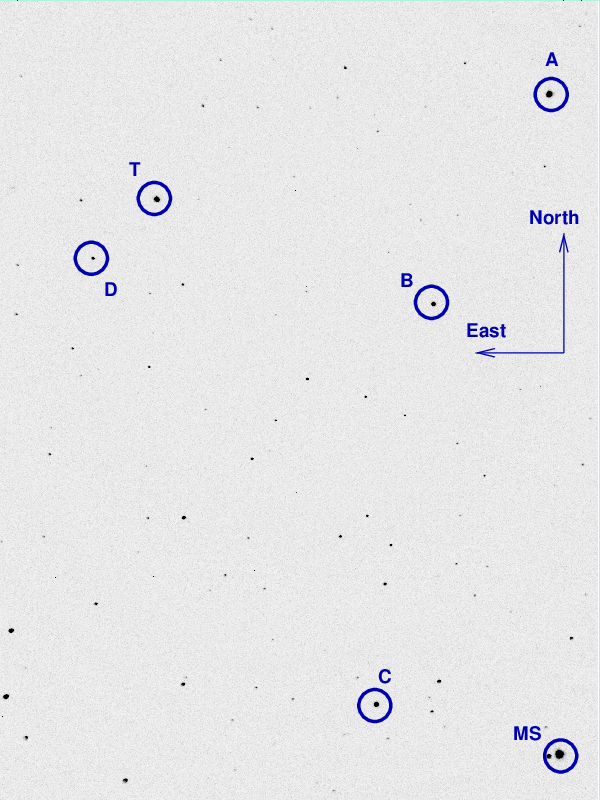
On the night of Jun 14/15, 2024, under good, conditions, I acquired images of the recurrent nova T CrB. This star undergoes outbursts at long intervals of 80 years or so. Its next outburst is predicted to occur soon, perhaps in 2024, and so I've joined the crowd who are monitoring it.
Members of RIT's Research for Undergraduates program in multimessenger astrophysics came for a look at the Moon at the start of the evening.
This recurrent nova brightens from by about 8 magnitudes (!), from V = 10 to about V = 2, around every 80 years. Will we see another outburst this summer?
These are my first observations of this field. I plan to follow it for a few months.
These observations involved:
Notes from the night:
The picture below shows a cropped image of the field of T CrB from Jun 14/15, 2024. The field of view is about 20 arcminutes across.

I've marked the location of several comparison stars, with magnitudes and names taken from the AAVSO's chart.
star name B V
------------------------------------------------------
A 000-BJS-901 11.190 10.566
B 000-BBW-805 11.840 11.187
C 000-BPC-198 13.049 12.336
--------------------------------------------------------------------------
When the target is centered, the finder TV shows this field:
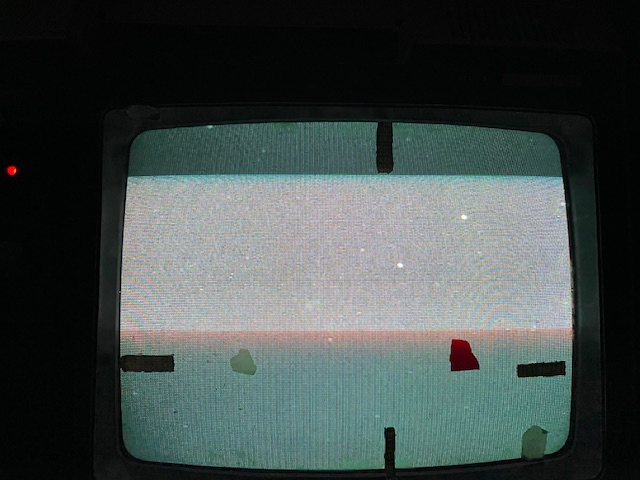
Here's the sky background over the course of the run. Note the clouds coming in second half.
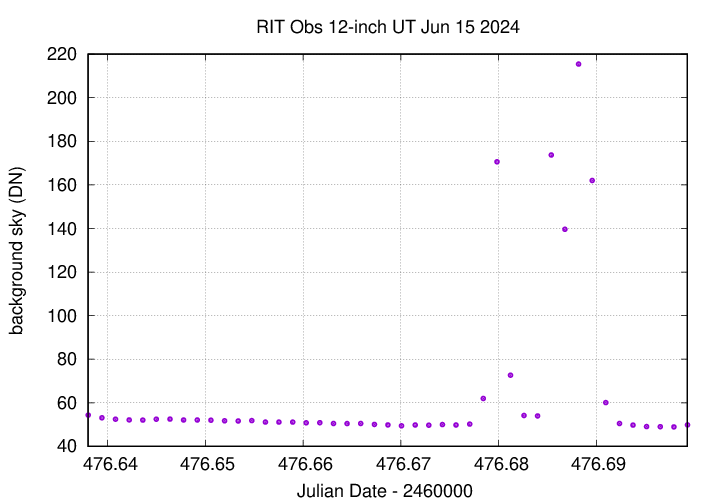
The FWHM was pretty steady.
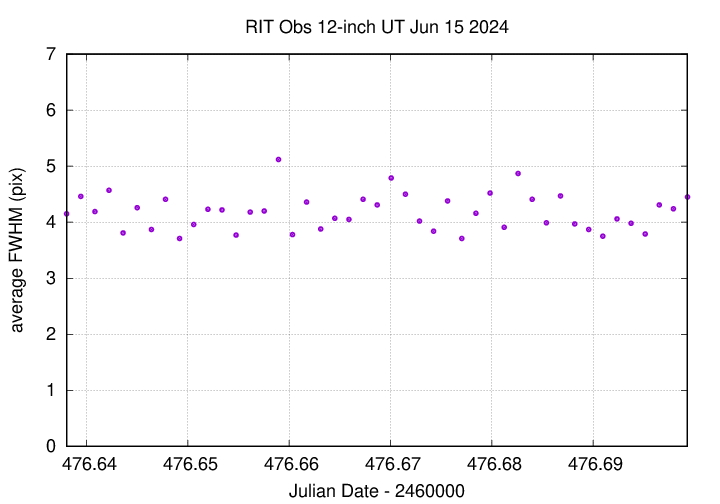
The graph below shows changes in the photometric zeropoint of an ensemble solution of the instrumental magnitudes over the course of the run. Note the clouds late.
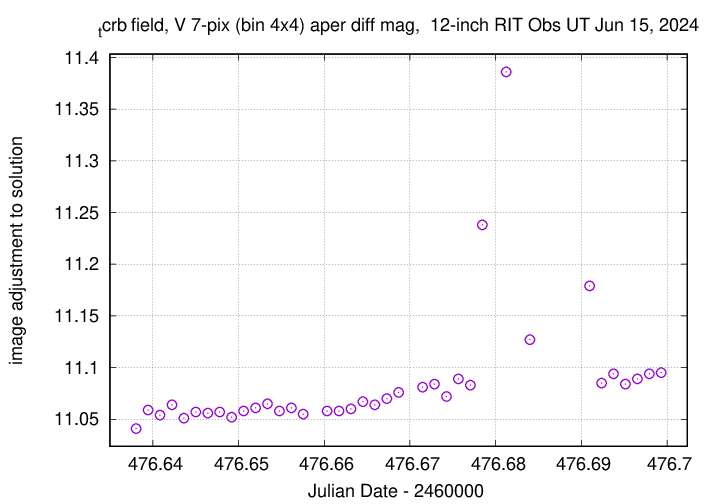
Using aperture photometry with a radius of 7 pixels in V filter (binned 4x4, each pixel is 1.036 arcsec, so a radius of 7.3 arcsec), and 7 pixels in B filter (binned 4x4, each pixel is 1.036 arcsec, so a radius of 7.3 arcsec), I measured the instrumental magnitudes of a number of reference stars and the target. Following the procedures outlined by Kent Honeycutt's article on inhomogeneous ensemble photometry, I used all stars available in each image to define a reference frame, and measured each star against this frame.
Sigma-vs-mag plots show that the floor in V-band was about 0.005 mag, which is not bad. It was 0.008 in B-band, which was hit harder by clouds (and trailing in some images).
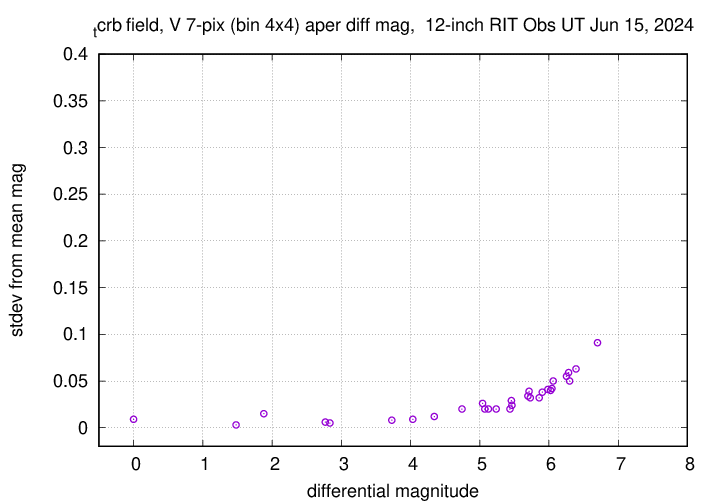
The measurements show relatively steady brightness.
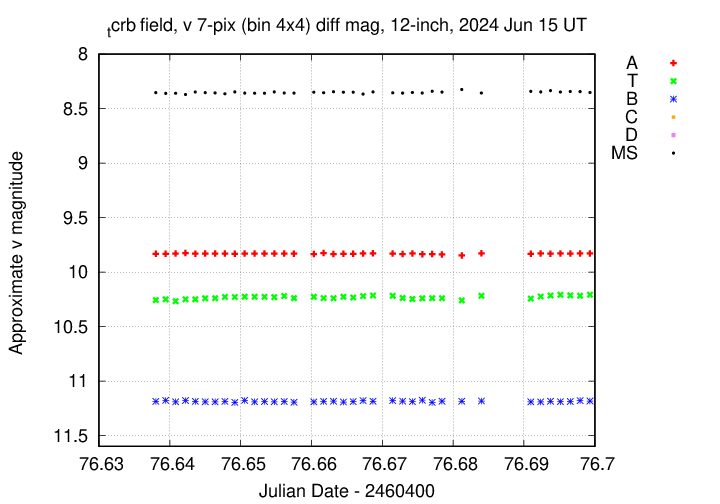
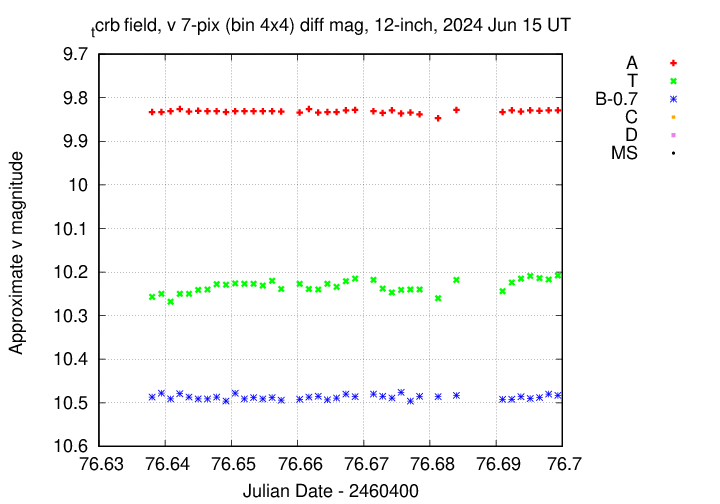
You can download my measurements below. A copy of the header of the file is shown to explain the format. First, the V-band data.
# Measurements of T_Crb made at RIT Obs, UT 2024 Jun 15, # in good conditions, # by Michael Richmond, # using Meade 12-inch LX200 and ASI 6200MM. # Exposures 30 seconds long, v filter. # Tabulated times are midexposure (FITS header time - half exposure length) # and accurate only to +/- 1 second (??). # 'mag' is a differential magnitude based on ensemble photometry # using a circular aperture of radius 7 pix = 7.2 arcseconds. # which has been shifted so AAVSO 000-BBW-805 has mag=11.187 # which is its V-band magnitude according to AAVSO chart X36711CB. # # UT_day JD HJD mag uncert Jun15.13802 2460476.63802 2460476.64144 10.257 0.005 Jun15.13942 2460476.63942 2460476.64284 10.250 0.004 Jun15.14081 2460476.64081 2460476.64423 10.268 0.004
Now, the B-band data.
# Measurements of T_Crb made at RIT Obs, UT 2024 Jun 15, # in good conditions, # by Michael Richmond, # using Meade 12-inch LX200 and ASI 6200MM. # Exposures 60 seconds long, b filter. # Tabulated times are midexposure (FITS header time - half exposure length) # and accurate only to +/- 1 second (??). # 'mag' is a differential magnitude based on ensemble photometry # using a circular aperture of radius 7 pix = 7.2 arcseconds. # which has been shifted so AAVSO 000-BBW-805 has mag=11.84 # which is its B-band magnitude according to AAVSO chart X36711CB. # # UT_day JD HJD mag uncert Jun15.13873 2460476.63873 2460476.64215 11.623 0.010 Jun15.14012 2460476.64012 2460476.64354 11.644 0.010 Jun15.14150 2460476.64150 2460476.64492 11.636 0.010
I've submitted these measurements to the AAVSO.
RIT runs a summer program for undergraduate students, sponsored by the National Science Foundation:
I invited these students to come to the RIT Observatory to learn about our telescopes, and to see the Moon. Fortunately, the weather cooperated, and we all had a chance to enjoy terrific views of craters and mountains on the lunar surface.